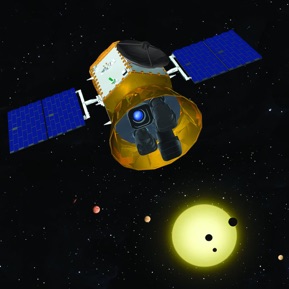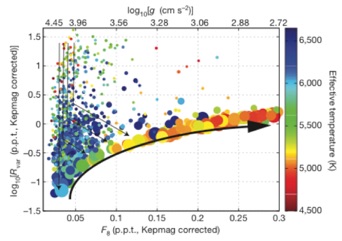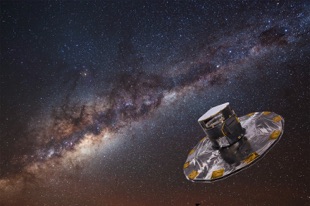Veloce will deliver to Australian astronomers a high-resolution, ultra-stabilised, red-wavelength-optimised spectrograph capable of delivering high-precision Doppler velocities for the transiting exoplanet host-stars being discovered now by southern hemisphere transit-planet searches, and for the coming wave of discoveries to be made by NASA’s Transiting Exoplanet Survey Satellite (TESS). In addition it will enable a vast suite of new research programs in Exoplanetary Science and Galactic Archaeology, as well as providing a sound base of ultra-stable infrastructure enabling future expansion to cover the full optical wavelength range at minimal cost.
Australia has an outstanding international reputation for the development of innovative astronomical instrumentation technologies, and their implementation in facilities that deliver ground-breaking new science at low cost. Facilities like the 2 Degree Field (2dF), TAIPAN and HERMES spectrographs on the Anglo-Australian Telescope (AAT) have delivered (or are about to deliver) massive scientific returns as a result of key investments in new technologies.
Veloce continues in this enviable tradition. It is a temperature- and pressure-controlled spectrograph providing high-throughput spectroscopy at a resolution of λ/Δλ≈80,000 with continuous wavelength coverage from 570nm to 900nm. It uses integral-field optical fibre technologies to reformat the telescope image at the entrance to Veloce Rosso, eliminating the image quality deficiencies of the AAT site so that Australia’s largest on-shore optical telescope can be used just as efficiently as a 4m telescopes at off-shore locations.
Veloce makes possible a suite of research programs at the forefront of modern astronomy: the confirmation of transiting exoplanets orbiting Sun-like and low-mass stars; measuring the system architectures of transiting systems via long-term follow-up; measuring the system architectures of exoplanetary systems discovered by ESA’s Gaia mission; and obtaining detailed abundances and long-term velocity monitoring for key classes of stars revealed by the AAT’s upcoming GALAH million-star spectroscopic survey. The vast range of high-resolution spectroscopy science that Veloce Rosso will enable, and the timing of key upcoming satellite missions that will provide exciting science targets in the southern sky well before the end of the decade, drives the urgent need for investing in this high-resolution spectroscopic facility for the AAT.
Veloce's design is driven by the technical issues required to undertake leading edge exoplanetary science and deliver a precision Doppler velocities at a level of stability at least an order of magnitudes better than is currently available to Australian astronomers. In doing so, it will additionally provide a facility enabling breakthrough science in research areas spanning almost all of Galactic astronomy via obtaining rapid and efficient high-resolution spectroscopy that delivers velocities and detailed elemental abundances for both bright and faint stars. We highlight here five key Science Themes where exploitation of this facility will be most productive in its first 5 years.
-
1.Detecting Habitable-Zone Planets Orbiting Nearby Low-Mass Stars. A major driver of the international endeavour in exoplanetary science is the search for habitable environments around other stars. Both NASA and ESA have ambitious plans for future space-based observatories with the goal of detecting atmospheric and surface conditions on exoplanets in a search for life (e.g. CHEOPS, EChO, WFIRST). While the direct detection of life by these missions is still some decades away, the field is nonetheless inexorably pushing to discover ever lower-mass planets (down to 1MEarth) in orbits that would make them “habitable”. Exactly what constitutes such a “habitable planet” requires understanding the evolution of early life to a far greater extent than we currently do. In the absence of this understanding, one particular habitability criterion has become a focus – the requirement that a habitable planet must support liquid water at its surface. This leads to the concept of the “habitability zone” – the range of orbital radii at which an Earth-like planet will receive a flux from its star that leads to surface temperatures in the range 0-100C (e.g. Kasting et al. 1993). In the Solar System the habitability zone is generally considered to range from the orbit of Venus to just inside the orbit of Mars. Hotter and more luminous stars will have habitability zones at larger orbital radii, and conversely smaller, cooler stars will have smaller zones. Detecting planets that are orbiting in the habitable zone, and that are small enough to be potentially rocky (rather than gas- or ice-giants), is now the major theme for exoplanetary science world-wide.
Low-mass M-dwarf stars offer multiple advantages making them the high-priority location in which make this search. -
•Their low masses (0.3-0.1 M) make the Doppler signature of a planet 3-10 times larger (and so easier to detect) than for a similar mass planet orbiting a Sun-like star.
-
•Their low luminosities mean that the orbits at which they receive a similar flux to that received by the Earth (i.e. are in the habitable zone) are much smaller, making the relevant orbital period shorter (so Doppler detection is less time consuming) and Doppler amplitudes larger (again making detection easier).
-
•Their spectra are rich in molecular features, which means the amount of Doppler information contained in each nm of spectrum is much larger than for an equal section of spectrum from a Sun-like star. Once again, Doppler detection becomes easier.
-
Veloce Rosso’s focus on precision Doppler spectroscopy at red wavelengths has been specifically chosen to align with this high-priority science goal. It is designed to achieve an order of magnitude improvement in Doppler stability over the current fibre-fed UCLES facility at the AAT. This will drop precision Doppler noise due to spectrograph instability below the 1m/s level, and provide 1m/s precisions down to I=11 from 1h exposures. This will deliver the capability to carry out searches for low-mass planets in habitable-zone orbits around M-dwarf stars with an efficiency unmatched in the Southern sky. The major competitor (HARPS on the ESO 3.6m telescope) is more stable at precision levels below 1m/s – however, this is not a level of stability required for this science. And with Veloce Rosso having a throughput at least a factor of 2 better, and sensitivity at red wavelengths beyond 680nm, it opens up a larger sample of stars for this key science program. -
2.TESS: Continuing the Kepler Revolution … Better. In just four short years, the search for transiting planets by NASA’s Kepler mission has completely revolutionised our knowledge of our Galaxy’s stars and planets. But Kepler does have its issues – most especially that it targeted planets orbiting faint and distant stars clustered in a single northern field, which made follow-up observations time consuming (due to faintness) and impossible from the south. The Kepler K2 mission will see this spacecraft being used in a different mode following the failure of two of its reaction wheels. This will deliver transit search and asteroseismology data in a series of fields spread along the ecliptic plane, making them accessible to the AAT. The majority of the discoveries form this mission will continue to be difficult to follow-up, though, as Kepler’s field-of-view imposes a focus on relatively faint stars.TESS (launching in Dec 2017) will operate in a very different mode. It will implement an all-sky survey of much brighter stars for transiting exoplanets, and is set to once more revolutionise our understanding of exoplanets. TESS’ exoplanetary discoveries will be made freely available to astronomers around the globe. Australia already has significant engagement with TESS through the planned FunnelWeb survey, which will deliver uniform low-resolution spectroscopy for TESS input catalogue stars in advance of the southern half of the TESS survey. (And this engagement is reflected by our membership on the TESS Target Selection Working Group.). However for Australia to fully exploit this potential we require a facility, like Veloce Rosso, able to deliver the critical high-precision Doppler follow-up observations required for the wave of exoplanet discoveries that TESS will make.

In addition to targeting a sample of Sun-like stars over the whole sky down to I=12, TESS will also target a high-priority sample of between 10,000 and 20,000 somewhat fainter (I=13) M-dwarf stars. That is, TESS will also target the detection of low-mass planets in potentially habitable orbits. Veloce Rosso’s design focus on precision velocities at red wavelengths will make it the southern facility for exploitation of new M-dwarf exoplanets that TESS will find. -
3.TESS : Finding the most stable stars. Of the many high profile results to emerge from the Kepler mission, one of the most profound is the identification and parameterization of a set of key variability signatures – F8 (or 8 hour “flicker”) and Rvar (or variability range) – by Bastien et al. in their 2013 Nature paper. They demonstrated a profoundly rich set of results measuring both the gravity and activity of stars using these signatures from Keplerphotometry. Excitingly these signatures provide a means to identify the most intrinsically velocity stable stars. TESS, then, will deliver a huge database of the best bright stars for Doppler exoplanet work spread across the whole sky. The capabilities Veloce Rosso+VeloceCal will provide to exploit those stars over the coming decade will be profound.

-
4.System Architectures: These most-stable-of-all-stars will be especially ideal for determining the frequency with which planet formation makes planetary systems with “Jupiter analogs”. That is, determining how common are planetary systems like our own, composed of gas giant planets formed and still orbiting beyond the frost line, with no inner gas giant planets? While transit and Doppler searches have told us precisely how common both gas-giant and low-mass planets are at orbital periods less than a few hundred days, the frequency with which Jupiters and Saturns form and remain in the outer regions of planetary systems remains poorly constrained at somewhere between 3 and 30% (Wittenmyer et al. 2011). These observations require the detection of small Doppler amplitude signals (3-10m/s) over long periods (>10y), which itself imposes stringent requirements for long-term stability. This is precisely the capability that VeloceCal will deliver.
-
5.Follow-up of Ground-based Transit Searches. In the lead-up to TESS’ launch, ground based searches like HATSouth (Bakos et al. 2013) and KELT (Pepper et al. 2013, 2008) will continue delivering detections for gas-giant planets at a regular rate. These systems are high-priority targets for follow-up observations to (1) confirm the transit detections, (2) measure planet masses and (3) measure planet densities. The latter measurements in particular are critical for planet formation and evolution theory, since it is only density measurements that can distinguish between rocky Super-Earth planets and icy sub-Neptune planets. These systems can be further explored using precision velocity measurements to probe the alignment (or misalignment) between their orbital planes and the spin axis of their host star by using Veloce Rosso to measure the “Rossiter-McLaughlin” Doppler anomaly that occurs as a planet is transiting its star.
-
6.The Gaia Connection. ESA’s Gaia mission (sci.esa.int/gaia) is set to have an impact on the study of stars within our Galaxy similar to the impact of Kepler on the study of exoplanets. Gaia is a rotating satellite scanning the entire sky with cameras pointing simultaneously in orthogonal directions, enabling its primary mission objective – an astrometric survey of the whole sky delivering proper motions and distances for stars down to 20th magnitude.
Gaia will detect exoplanets astrometrically (i.e. via the position wobble of a star across thesky as a planet orbits, as distinct from the Doppler technique which detects wobble into-and-out-of the plane of the sky). These systems will tend to be detected at longer periods and larger orbital separations (i.e. much like the outer Solar System gas giants Jupiter and Saturn). Every system detected in this way will then be a high-priority target for future monitoring using Doppler techniques to determine how common are inner system architectures like the Solar System.
-
7.Gaia and GALAH. The science of Galactic Archaeology is a key focus of a second aspect of the Gaia mission, and of a new survey starting this year on the AAT called GALAH. Australia will make a major investment in GALAH (almost 1/3rd of all time on the AAT – valued at around $1m per annum – for the next 5 years), which measure both velocities and detailed elemental abundances for a million stars spread across the southern sky, in an effort to unscramble the detailed evolutionary history of our Galaxy. Gaia will also deliver velocities and (less precise) abundances for many millions of stars spread over the whole sky. The combination of full space velocities and detailed characterization will make the Gaia and GALAH databases a treasure trove of rare and exotic stars. Because of the limited wavelength coverage and velocity precision of Gaia and of the HERMES spectrograph (which GALAH uses), follow-up data will be critical for determining elemental abundances for additional elements to higher precision, and for monitoring velocities and variability over longer timescales. Veloce Rosso will deliver a facility capable of doing exactly these kinds of observations in a manner far more efficient, stable and reliable than any current Australian facility.
A Facility to Power Astronomers for Decades. Veloce Rosso will deliver a capability that will maximise the utility of Australia’s significant investment in the AAT, focus on science programs at the international fore-front of astronomy, and provide a low-cost upgrade path to a facility that can eventually deliver one-shot, ultra-stable, high-resolution spectroscopy of the entire optical (370-900nm). It will be a facility able to power cutting-edge astronomy in Exoplanetary Science and Galactic Archaeology for the decade ahead, and beyond.

References
-
Arriagada et al. 2013, ApJ, 771, 42
-
Bakos, G. 2013, PASP, 125, 154
-
Bastien, F. et al. 2013, Nature, 500, 427
-
Beaulieu, J.-P., et al. 2006, Nature, 439, 437.
-
Borucki, W.J. et al. 2010, Science, 327, 977
-
Charbonneau, D., Brown, T.M., Latham, D.W. & Mayor, M. 2000, Astrophysical Journal Letters, 529, L45
-
Crane J.D. et al. 2010 SPIE, 7735, 170.
-
Hirsch, J. 2005, Proc. Nat. Acad. Sci, 102, 46.
-
Ireland et al, 2012, Proc SPIE 8446E, 29I
-
Kalas, P. et al. 2008, Science, 322, 1345
-
Kasting, J. F., Whitmire, D. P., & Reynolds, R. T. 1993, Icarus, 101, 108
-
Mahadevan, S. et al. 2014, SPIE 9147, doi: 10.1117/12.2056417
-
Marcy. G. & Butler, R.P. 1996, Astrophysical Journal Letters, 464, L147
-
Mayor, M. & Queloz, D. 1995, Nature, 378, 355
-
Marois, C. et al. 2008, Science, 322, 1348
-
Murphy, M. et al. 2007, MNRAS, 380, 839
-
Murphy, M. et al. 2012, MNRAS, 422, 761
-
Pepe, F. et al., 2014, Astronomische Nachrichten, 335, 19
-
Pepper, J. et al. 2008, AJ, 135, 907
-
Pepper, J. et al. 2012, PASP, 124, 230
-
Steinmetz, T. et al. 2008, Science, 321, 1335
-
Stürmer J. et al. 2014, Proc. SPIE 9151, doi:10.1117/12.2056541
-
Tinney, C.G. et al. 2001, Astrophysical Journal, 551, 507
-
Tokovinin et al 2013, PASP, 125, 1336
-
Winn, J. 2010, in “Exoplanets”, ed. S. Seager (Univ. Arizona Press: Tucson), arxiv.org/1001.2010

